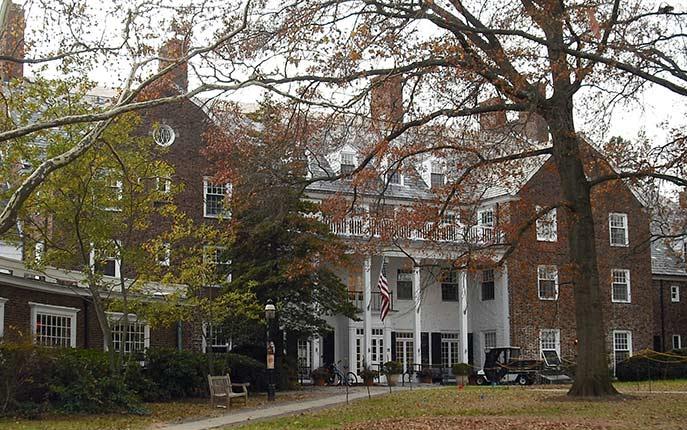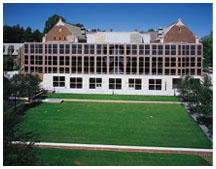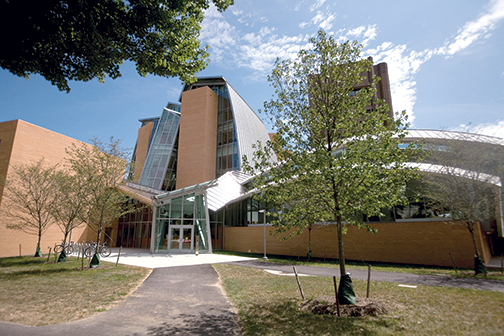Life is what happens to you while you’re busy making other plans.
– John Lennon, Beautiful Boy, 1980 (after Allen Saunders)
In our last thrill-packed episode, we looked back on Princeton’s institutional strategic-planning efforts over its first 220 years; its successes (examples: moving to Princeton from Newark, inventing the academic precept) and not-so-muches (examples: the 30-year delay in building Firestone Library, the entire 10-year administration of Ashbel Green 1783). We also considered the innate friction between orderly strategy and the incessant need for change, which gives life to an institution engaged in the search for knowledge. We ended in front of Dillon Gym exactly 50 years ago with ace strategist Butch van Breda Kolff ’45 and his boys on top of the team bus, celebrating Princeton’s third-place finish in the NCAA basketball tournament. Planning was about to become something else entirely.
After the cheering at the gym faded away, batches of freshmen returned to their brand-new dorm rooms down the hill in the New New Quad (since replaced by the Butler College dorms in an angst-ridden exercise). Just opened in 1964, the rooms were utilitarian, with nice lounges and everything a student might need, being a hike from Commons, Firestone, or Prospect Street. But it did share with all the dorms of the time (and even some classroom buildings) a limitation that brings us back to our consideration of strategic planning: None of the five new dorms had a single women’s bathroom.
Four years later, Princeton was coeducational.
Now, you can pay homage to orderly planning as much as you might like, but when the trustees decide after a thorough examination that Princeton won’t be competitive without undergraduate women, and immediately start accepting their applications, you rapidly change plans. From 1969 to the mid-1980s, Princeton completely reinvented its undergraduate student body and the way it was organized. The number of undergrads increased (partly to minimize the reduction in men as women became more numerous) from 3,200 in 1968 to 4,500 in 1980, a 40 percent jump in 12 years; in the ensuing 35 years it’s grown only 16 percent more. This not only turned hundreds of triples into quads and led to the instant creation of Princeton Inn College (now Forbes College) and the Spelman Halls (thanks to trustee Laurance Rockefeller ’32), but it called into question the quality of life for what had become an almost entirely resident student body. The result in 1977 was the Committee on Undergraduate Residential Life (CURL), which spent more than a year developing a set of recommendations that became the five undergraduate colleges (Whitman was added when its facility was built in 2007) and the complete redo of freshman and sophomore life. It took four years to fully implement, including Wu Hall and Butler, Rockefeller, and Mathey colleges, and while it stopped short of significantly impacting upperclassmen, it ate up huge amounts of creative effort and tens of millions of dollars – President Bill Bowen *58 and the development office had hit up big givers for more than $125 million during the ’70s to make it all happen.
To finish all this student expansion off and reset strategic planning toward the academic side, Princeton mounted its first full-blown capital campaign in 20 years in 1982. Aiming for $275 million, it showed the alumni to be in line with both the University’s aspirations regarding a fairly diverse portfolio of athletic facilities (e.g., Lenz Tennis Center), increased scholarship aid, and major educational expansion – the department of molecular biology, later the linchpin of the genomics program as well, was entirely a creation of the drive, for example. A Campaign for Princeton also showed unimagined and somewhat stunning capacity for support: It ended up with $410 million and a realization that institutional strategy at Princeton had entered a new, aggressive era. When, two years afterward, Bowen stepped down to universal acclaim for overseeing 16 years of ceaseless change, the trustees didn’t look to an assistant professor of classics (which the great Bob Goheen ’40 *48 had been when he was named president in 1957). They hired the president of the University of Michigan.
So, inevitably, the term strategic plan was first used in connection with Princeton’s future in November 1991. Initiating a broad-ranging study – everything from the University’s size to possible new graduate schools was supposedly on the table – Provost Hugo Sonnenschein (later the president of the University of Chicago) insisted, extraordinarily, that the administration “has no clear vision of the future and will incorporate ideas from as many vantage points as possible.” When the smoke cleared after two years of discussions, the final report from multiple committees, brought together and prioritized by President Harold Shapiro *64, was intriguing for its strategy: Go with your best pitch. While giving a nod to research, it pictured improvements across the board in undergraduate teaching and living, more diverse courses, more senior faculty teaching frosh and sophs, upgraded dorms, better athletic facilities, significantly ramped-up student aid, and, most urgently, an honest-to-God student center (where have we heard that before? Remember, Whig-Clio offered Clio Hall for one in 1928). All this, and it strongly urged that the size of the student body not be changed; it was completely a qualitative effort, a conscious shot at creating the best undergraduate education the trustees could imagine.
With that kind of agenda, you can bet the undergrad alumni were enthused – the resulting Anniversary Campaign for Princeton (masterfully marketed as One Accord, with huge “ONE”s appearing everywhere) blew its $750 million target away with $1.14 billion in hard cash; the results included Frist, new engineering and music libraries, the new Princeton Stadium and Class of 1952 Stadium, the replacement of student loans with grants, equal aid for international students, dorm renovations for Little, Blair, and Patton plus the new Scully Hall; meanwhile, 25 new professorships and major initiatives like genomics got going with a bang. If you have thought, in your idle moments, that the ascendance of Princeton to first in various college rankings over the last 20 years is simply a matter of cream rising to the top, I hate to tell you that it’s actually much more a result of conscious design and strategic priorities laid out in Shapiro’s 58-page plan of 1993.
But of course, then there’s that pesky incessant-change problem; it comes with the territory. By 2005, with Shirley Tilghman four years on the job as president, the new back-of-the-envelope list again had lengthened, and (in the worst-kept secret of modern times at Princeton, which is really saying something) a new campaign initiative was in the wind. The resulting Campus Plan of 2006 pointed out with mapped clarity where the emphasis would be in the next 10 years: a huge redo of Firestone Library on the fly, vastly expanded neuroscience, ecoscience, and arts initiatives , and a series of efforts to bring grad-student and junior-faculty life up to undergrad levels. It also provided expansion of the undergraduate student body to 5,200, with the notable addition of Whitman College, enabling both the size increase and the option for juniors and seniors to stay in the colleges. The resulting Aspire Campaign of 2007-2012 – which coincided with the entirety of the worst world economic downturn since the Great Depression – raised $1.88 billion, 7 percent over its target.
But if you read the fine print in the above paragraph, you noticed the words “10 years.” And indeed, virtually every substantial item will be done by 2016 (thanks to such fine folks as Meg Whitman ’77, the late Peter Lewis ’55, and a host of others). So, in a clear sign of a new, perpetual-planning era, we already have on the table the beginnings of the new new campus plan. Starting off with the time-saving advantage of having a Princeton provost promoted to president for the first time since Bowen in 1972, Chris Eisgruber ’83 has set up a process to yield a new 10-year plan in 2016, immediately on the heels of the old one. The list of questions that various working committees will be looking at in preparation is daunting; the task forces organized to confront them run the gamut of the community, in great, fascinating detail: statistics and machine learning, sponsored research, the colleges, internationalization, online learning, on and on. Ways for Princeton to be of added service are sought; student body expansion is again on the table.
When the final results of this process are in place in a year or so, Princeton will have a new set of 10-year targets. Tacitly, the accompanying question will be: Are we talking another capital campaign, and if so, when? Only seven years elapsed between the end of the Anniversary Campaign and the nominal start of Aspire (there’s always a silent period beforehand). Could Princeton start another campaign in 2019, or even earlier? Should it, considering Annual Giving is now knocking down $60 million per year, with increasing participation? Can an intentionally modest-sized institution go to the well too often or too big? But then, can we ignore or defer the chance to lead?
Imagine the strategic difficulty if we weren’t number one.















No responses yet